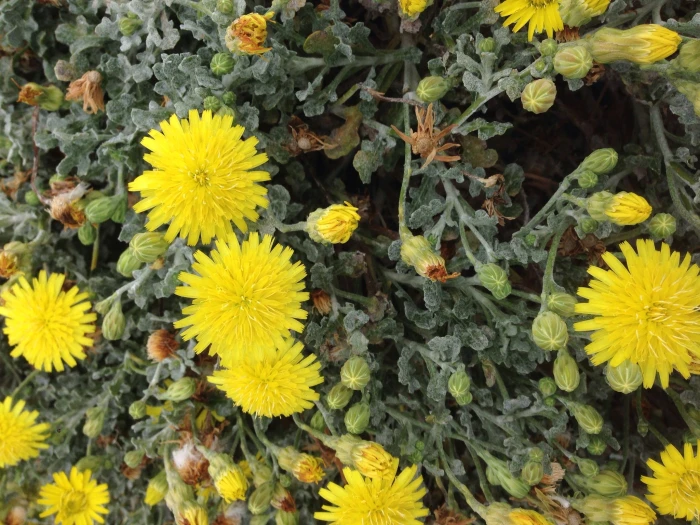Dunedelion
(Malacothrix incana)
Dunedelion (Malacothrix incana)
/
/

Adam J. Searcy
CC BY 4.0
Image By:
Adam J. Searcy
Recorded By:
Copyright:
CC BY 4.0
Copyright Notice:
Photo by: Adam J. Searcy | License Type: CC BY 4.0 | License URL: http://creativecommons.org/licenses/by/4.0/ | Rights Holder: Adam J. Searcy | Publisher: iNaturalist | Date Created: 2017-05-24T17:37:45Z |
























Estimated Native Range
Climate Requirements for Plano, Texas
| This Plant | Your Site | Plant Suitability for Your Location | ||
|---|---|---|---|---|
| • Precipitation | 8" - 25" | 39" | Aquatic | Aquatic |
| • High Temp. | 67°F - 92°F | 96°F | Your summers may be too hot for this plant. | Too hot |
| • Low Temp. | 33°F - 49°F | 33°F | Your winter temperatures are normal for this plant | Excellent |
This plant may not grow well at your location - your precipitation is too high.
Summary
Malacothrix incana, commonly known as dunedelion, is a perennial herb endemic to California, specifically to coastal sand dune ecosystems on the Channel Islands and isolated mainland areas in San Luis Obispo and Santa Barbara Counties. It typically forms a leafy mound that can reach up to 28 inches in height and varies in texture from hairless to densely hairy. The leaves of Malacothrix incana are either smooth-edged or dull-lobed, and it produces bright yellow ray florets that bloom in the spring and summer, adding a splash of color to the dunes. The flowers are modest in size but can be quite showy when the plant is in full bloom.
Dunedelion is valued for its ability to thrive in harsh, sandy environments, making it an excellent choice for restoration projects and xeriscaping in coastal areas. It is also of interest for its ecological role in supporting native pollinators. In cultivation, it requires well-drained sandy soils, minimal water once established, and full sun exposure to mimic its natural dune habitat. While not commonly used in traditional garden settings, it can be a unique addition to native plant gardens or coastal landscapes. Care should be taken to avoid hybridization with other Malacothrix species when planting in transition areas where natural populations occur.CC BY-SA 4.0
Dunedelion is valued for its ability to thrive in harsh, sandy environments, making it an excellent choice for restoration projects and xeriscaping in coastal areas. It is also of interest for its ecological role in supporting native pollinators. In cultivation, it requires well-drained sandy soils, minimal water once established, and full sun exposure to mimic its natural dune habitat. While not commonly used in traditional garden settings, it can be a unique addition to native plant gardens or coastal landscapes. Care should be taken to avoid hybridization with other Malacothrix species when planting in transition areas where natural populations occur.CC BY-SA 4.0
Plant Description
- Plant Type: Shrub, Herb
- Height: 0.5-1.5 feet
- Width: 0.5-1 feet
- Growth Rate: Moderate
- Flower Color: N/A
- Flowering Season: Spring, Summer, Fall
- Leaf Retention: Deciduous
Growth Requirements
- Sun: Full Sun
- Water: Low
- Drainage: Fast
Common Uses
Drought Tolerant, Low Maintenance, Rock Garden
Natural Habitat
Endemic to California’s coastal sand dune ecosystems and transition areas on the Channel Islands and isolated mainland areas in San Luis Obispo and Santa Barbara Counties
Other Names
Common Names: Gray Desertdandelion, Dune Malacothrix, Woolly Desertdandelion
Scientific Names: Malacothrix incana, Malacomeris incanus, Malacothrix incana var. incana, Malacothrix incana var. succulenta, Malacothrix incana var. succulenta, Malacothrix succulenta
GBIF Accepted Name: Malacothrix incana